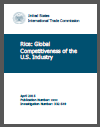
The global rice market is characterized by relatively low trading volumes and heavy government intervention in both imports and exports, reports the U.S. International Trade Commission in its latest publication.
Exports only account for 8% of global rice production, significantly less than for other grains and oilseeds even though rice serves as a staple in the diet of more people than any other food, according to the report.
Prepared at the request of the U.S. House of Representatives Committee on Ways and Means, the report states that government intervention is often aimed at keeping prices affordable, especially for low-income consumers. In some cases, government intervention also encourages domestic production to promote national self-sufficiency. Other highlights of the report include:
- Global rice production and consumption are highly concentrated in Asia. Rice is the primary staple food for most of the population in Asia, especially for the poor. [Read More]
- The top three worldwide exporters are India, Thailand, and Vietnam, followed by Pakistan and the United States.
- Of government policies for rice in place in 2013, import tariffs on rice in major consuming countries had the largest impact on U.S. production and exports. [Read More]
- The United States faces little direct competition in its domestic market, but in recent years it has lost market share in key export markets, such as Mexico, Central America, the European Union, Haiti, and Ghana. The United States exports about 50 percent of its production. [Read More]
- The major rice producing countries can be characterized as follows: 1) major consumers and surplus producers, 2) major consumers and importers, or 3) major exporters but not major consumers.
- Countries that are both major rice consumers and surplus producers, such as India and Thailand, typically provide support for rice producers and consumers. These countries also impose export controls if prices rise.
- Countries that are principally rice consuming and importing countries, such as Indonesia and the Philippines, typically provide a support for rice producers and consumers, and maintain control of rice imports, generally through state trading.
- Countries that are major exporters of rice but not major consumers, such as the United States and Uruguay, typically provide less extensive support for rice producers than do major consuming countries.
- [Read More]
- Countries that are both major rice consumers and surplus producers, such as India and Thailand, typically provide support for rice producers and consumers. These countries also impose export controls if prices rise.
- Low-cost producers of long grain white rice (the most-commonly traded rice type and form) include Burma, Cambodia, India, Pakistan, Uruguay, and Vietnam, while the most highly reliable exporters of long grain white rice include Uruguay and the United States. [Read More]


















